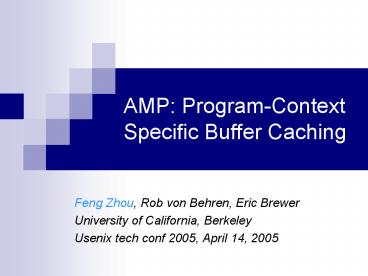AMP: ProgramContext Specific Buffer Caching - PowerPoint PPT Presentation
1 / 19
Title:
AMP: ProgramContext Specific Buffer Caching
Description:
Utilizing frequency: ARC (Megiddo & Modha 03), CAR (Bansal & Modha 04) ... info about past requests. from same PC. go to cache. partition using. appropriate. policy ... – PowerPoint PPT presentation
Number of Views:44
Avg rating:3.0/5.0
Title: AMP: ProgramContext Specific Buffer Caching
1
AMP Program-Context Specific Buffer Caching
- Feng Zhou, Rob von Behren, Eric Brewer
- University of California, Berkeley
- Usenix tech conf 2005, April 14, 2005
2
Buffer caching beyond LRU
- Buffer cache speeds up file reads by caching file
content - LRU performs badly for large looping accesses
- DB, IR, scientific apps often suffer from this
- Recent work
- Utilizing frequency ARC (Megiddo Modha 03),
CAR (Bansal Modha 04) - Detection UBM (Kim et al. 00), DEAR (Choi et al.
99), PCC (Gniady et al. 04)
1
2
3
4
1
2
3
4
Access stream
, Cache Size 3
0 Hit Rate for any loop over data set larger than
cache size
3
Program Context (PC)
- Program context current program counter all
return addresses on the call stack
Ideal policies 1 MRU for loops 2, 3 LRU/ARC
for all others
4
Contributions of AMP
- PC-specific organization that treats requests
from different program contexts differently - Robust looping pattern detection algorithm
- reliable with irregularities
- Randomized partitioned cache management scheme
- much cheaper than previous methods
Same idea is developed concurrently by Gniady
et al (PCC at OSDI04)
5
Adaptive Multi-Policy Caching (AMP)
fs syscall()/page fault
calc PC
(block,pc)
time to detect?
detect pattern using info about past requests
from same PC
(pattern)
(block,pc,pattern)
Default partition(LRU/ARC)
go to cache partition using appropriate policy
MRU1
buffercache
MRU2
6
Looping pattern detection
- Intuition
- Looping streams always access blocks that has not
been accessed for the longest period of time,
i.e. the least recently used blocks.1 2 3 1 2 3 - Streams with locality (temporally clustered
streams) access blocks that has been accessed
recently, i.e. recently used blocks.1 2 3 3 4 3
4 - What AMP does measure a metric we call average
access recency of all block accesses
7
Loop detection scheme
- For the i-th access
- Li list of all previously accessed blocks,
ordered from the oldest to the most recent by
their last access time. - pi position in Li of the block accessed (0 to
Li-1) - Access recency Ripi/(Li-1)
pi/(Li-1)
1
Ri
0
Li
oldest
most recent
8
Loop detection scheme cont.
- Average access recency R avg(Ri)
- Detection result
- loop, if R lt Tloop (e.g. 0.4)
- temporally clustered, if R gt Ttc (e.g. 0.6)
- others, o.w. (near 0.5)
- Sampling to reduce space and computational
overhead
9
Example loop
- Access stream 1 2 3 1 2 3
- R 0, detected pattern is loop
10
Example non-loop
- Access stream 1 2 3 4 4 3 4 5 6 5 6, R 0.79
11
Randomized Cache Partition Management
- Need to decide cache sizes devoted to each PC
- Marginal gain (MG)
- the expected number of extra hits over unit time
if one extra block is allocated - Local optimum when every partition has the same
MG - Randomized scheme
- Expand the default partition by one if ghost
buffer hit - Expand an MRU partition by one every
loop_size/ghost_buffer_size accesses to the
partition - Expansion is done by taking a block from a random
other part. - Compared to UBM and PCC
- O(1) and does not need to find smallest MG
12
Robustness of loop detection
tctemporally clustered Colored detection
results are wrongClassifying tc as other is
deemed correct.
13
Simulation dbt3 (tpc-h)
Reduces miss rate by gt 50 compared to LRU/ARC
Much better than DEAR and slightly better than
PCC
14
Implementation
- Kernel patch for Linux 2.6.8.1
- Shortens time to index Linux source code using
glimpseindex by up to 13 (read traffic down 43) - Shortens time to complete DBT3 (tpc-h) DB
workload by 9.6 (read traffic down 24) - http//www.cs.berkeley.edu/zf/amp
- Tech report
- Linux implementation
- General buffer cache simulator
15
(No Transcript)
16
DBT3 on AMP implementation
- Overall execution time reduced by 9.6 (1091 secs
?986 secs) - Disk reads reduced by 24.8 (15.4GB ? 11.6GB),
writes 6.5
17
Simulation scan
18
Loop pattern detection
- Given an access stream from a PC, decide whether
it follows a looping (or near looping) pattern - Difficulties
- Global property
- Irregularities in access streams
19
Correctness of partition size adaptation
- During time period t, number of expansion of ARC
is -
(B1B2ghost_buffer_size) - The number of expansions of an MRU partition i is
- They are both proportional to their respective MG
with the same constant































